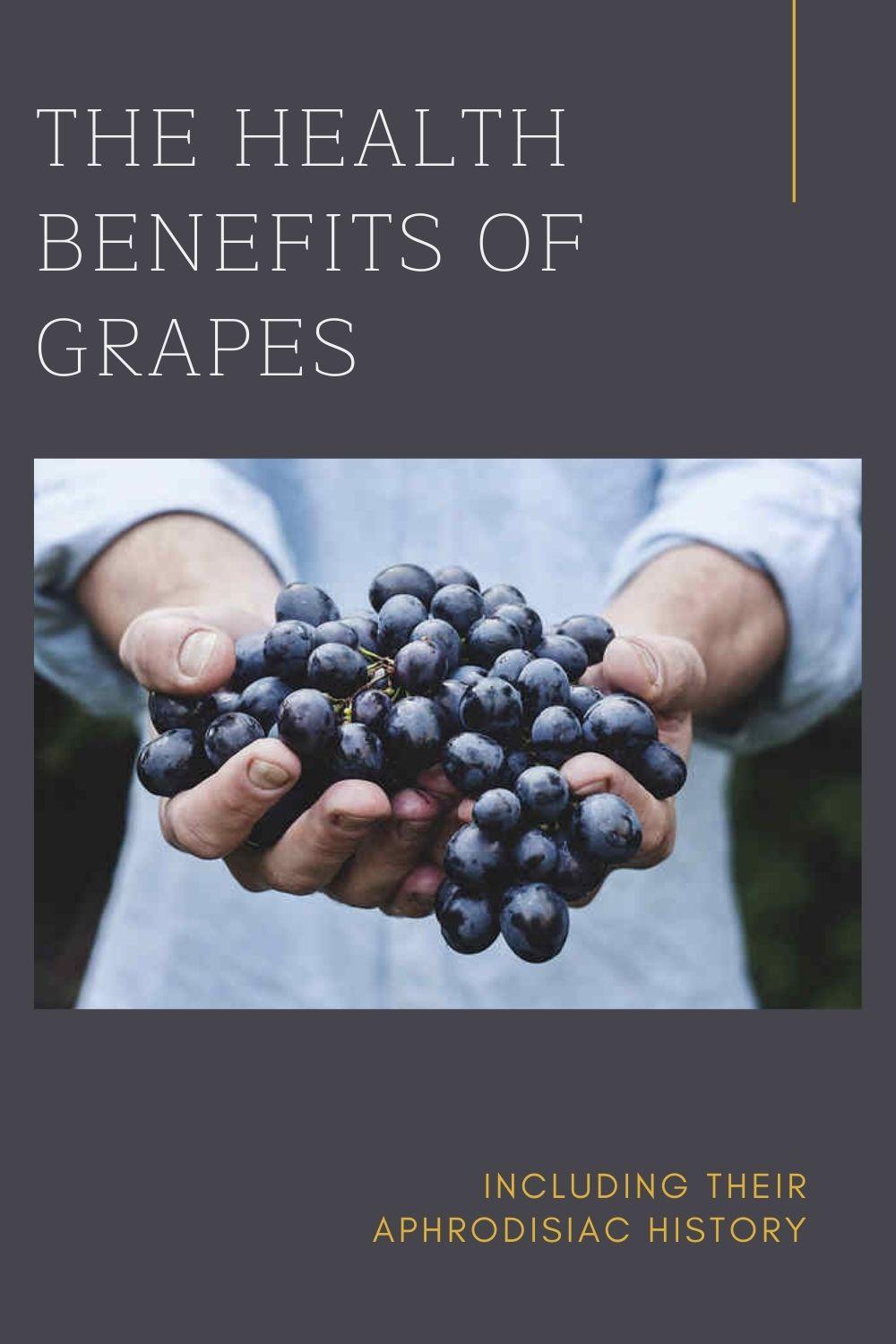
If you want to look at an ingredient with a long and fascinating history, it doesn’t get much better than a grape. And if you want to eat a seasonal ingredient in autumn that packs a nutritional punch, well, that would be the grape again.
Grapes’ benefits are as impressive as is this fruit’s history. But if you truly want to understand man’s love affair with grapes, you need to start with the fruit’s history as an aphrodisiac.
Are grapes an aphrodisiac?
The aphrodisiac history of grapes is as old as the history of mankind. The evidence stretches all the way back to ancient Egypt. It entwines the history of man with that of wine.
How? When archeologists unlocked the mysteries of ancient Egyptian tombs, they found traces of wine. And that discovery revealed that man had indulged in the elixir of romance, also known as fermented grape juice, since the beginning of civilization.
RELATED: Red Wine Aphrodisiac & Sexual Benefits
Since those first attempts at fermenting the fruit into an alcoholic beverage, wine has served as the muse of poets, songwriters and dreamers. And in most cases, the drink is mentioned in the context of romance, eroticism, and sometimes downright debauchery.
But even without the transformation into a drink of love and song, the aphrodisiac history of grapes is linked symbolically with romance, fertility and virility.
Grapes as a symbol of fertility
The ancient Romans, acknowledged as the first civilization to cultivate grapevines, declared both wine and fresh grapes emblems of Bacchus, God of Ecstasy. (He was also the God of Fertility.)
And pre-dating the Romans, the ancient Greeks made it a tradition to give clusters of freshly picked grapes to newlyweds. This custom was somewhat of a fertility right. You see, it was believed that the grape seeds would bless the happy couple with many children.
RELATED: Caviar – aphrodisiac, indulgence, health food
What are the nutritional benefits of eating grapes?
When you consider the grape, it’s easy to see why this summer and autumn fruit was first regarded as an aphrodisiac. The sweet jewels make perfect finger food. The grape is a plump, luscious fruit. And for this reason, it is often used in romantic literature to symbolize a woman.
But a fruit so sweet and juicy, well it may leave you wondering, “Are grapes good for you?” The short answer is “Yes!” In fact, you may be shocked at all the health benefits of grapes.
Grapes are a source of fiber
For starters, grapes do have fiber. Unlike some fruits, which are preferable when peeled, we typically eat grapes skins and all. And grape skin is where you get the fiber. It isn’t as remarkable a serving of fiber as you’ll get from some other healthy foods, like peanuts. But a one-cup serving offers about 1.4 g of the fiber your body needs every day.
Benefits of grapes for sexual health
The vitamins in grapes are not as remarkable as some other fruits. But they are a good source of vitamin K. (One serving offers about 28% of your daily intake.) Although K doesn’t directly impact sexual health, it is linked with cognitive health and it may help lower blood pressure.
Grapes are a source of vitamin B2, which is one of the vitamins needed in hormone production. And it offers about 6% of your daily intake of vitamin B6. And this is a vitamin you need if you ever want to experience an orgasm. Why? This vitamin is used in the synthesis of the neurotransmitter epinephrine. Here’s some additional information on epinephrine and its role in sexual climax.
Grape benefits for male sexual health
While most of the health benefits of grapes will help both men and women in the bedroom, there are a few notable nutritional benefits that can really help men. Grapes are a surprising source of vitamin C. One cup of grapes offers about 27% of the recommended daily intake. And a deficiency in vitamin C is linked with erectile dysfunction. Because vitamin C promotes blood flow, it is believed to be one of the essential nutrients to maintaining sexual health.
Grapes also offer the minerals potassium and manganese. Both potassium and manganese are vital to men’s sexual health. Here is some additional information on why all men need to get enough manganese.
The health benefits of grapes for heart and brain health
The best-known health benefits of grapes come from their antioxidant content. You may have heard of resveratrol. This is a polyphenol found in grapes linked with many health benefits, particularly heart health. However, the resveratrol and other antioxidants in grapes is found primarily in the skins and seeds, which means that different types of grapes have different nutritional benefits.
RELATED: Discover why grapes grown at high altitude are healthier
Benefits of purple grapes (or red grapes)
Dark-skinned, such as purple or red grapes have health benefits greater than those found in white or green grapes. That’s because darker-skinned grapes are denser in phytonutrients than lighter-skinned grapes, this includes having a higher resveratrol content.
Interestingly, these benefits are also found in red and purple grape juice and red wines. According to the Mayo Clinic, grape juice health benefits include promoting healthy blood pressure and heart health.
White grapes benefits
Of course, this isn’t to say that there aren’t health benefits of white grapes.
White grapes do have antioxidant benefits but not generally in the same concentration as is found in darker-skinned grapes. However, skin color is not the only factor that influences the nutrition value of grapes. Geography and variety of grape also impact the health benefits of grapes.
RELATED: Champagne Aphrodisiac & Health Benefits
Grapeseed oil benefits
Unfortunately, the greatest health benefit of grapes doesn’t come from the sweet flesh. The part of a grape that has the most potential to impact libido–and overall health–is a part usually not eaten. It turns out that the oil found in grape seeds has the potential to offer the body a lot of nutrition, beneficial to overall and reproductive health.
Modern science reveals that grapeseed oil is an even greater source of antioxidants with free radical-fighting effects than is the fruit of the grape. And it’s a source of vitamin E, a nutrient known for its role in supporting the health of your reproductive organs.
But since you probably don’t crunch the seeds when eating a grape, you may be wondering how you are supposed to get the benefits of grapeseed oil.
For one thing, you can use grapeseed oil in cooking and those antioxidants will set to work while you up your daily vitamin E intake. I like to use it as a base for a salad dressing.
Grapeseed oil skin benefits
Grapeseed oil is also recognized as an inexpensive and natural beauty aid. It can be used for skin and hair health. As a beauty aid, grapeseed is may slow signs of aging, reduce pore size and moisturize skin. It can also be used as sensual massage oil with added nutritional benefits for skin health.
Lastly, you can always try taking grapeseed oil as a supplement, like this one I reviewed to improve the circulation and appearance of your legs.
The tradition of feeding grapes
One of the most powerful images of seduction is that of hand-feeding the aphrodisiac grapes to your reclining lover. The concept of feeding grapes comes from imagery of the Greek god Dionysus enjoying grapes fed to him. There is a belief that grapes were once fed to rulers and aristocrats by servants and concubines.
Whether or not this ever actually happened is unclear, however, the psychology of this indulgence has stuck and today, the thought of feeding someone grapes is considered a sensual act.
How to serve grapes to your lover
Let go of any inhibitions and embrace the power of the sexy image of feeding grapes.
Just go for it and dangle a perfectly formed bunch of grapes over your lover’s reclining body and feed them grapes in this seductive manner.
But feeding someone grapes isn’t the only sexy way to use this fruit. In summer, freezing the grapes can prove a sinful way to beat the season’s heat. (Try passing one to your lover’s mouth with your teeth or rolling one over you’re lover’s warm, bare flesh.)
One viral, online suggestion for using frozen grapes sexually is for a woman to place frozen grapes in her mouth before performing oral sex on a man. Supposedly the mixture of hot and cold sensations elevates the sensual experience.
But if either of these manners of eating grapes is outside of your comfort zone, don’t worry. You will still get all the health benefits of grapes if you continue to eat them in a conventional way.
Discover more of the world’s greatest aphrodisiac foods
This article was written in 2010 and most recently updated in October 2020.
- A Champagne Shrub Cocktail for Your Next Romantic Evening - May 2, 2024
- Savory Ricotta Toast with Asparagus and Lemon Zest - May 1, 2024
- Heirloom Egg Benefits: Are Heirloom Eggs the Most Aphrodisiac Eggs? - April 29, 2024



thanks for the information